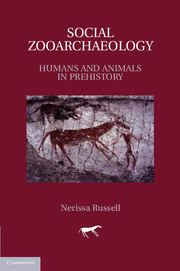Book contents
- Frontmatter
- Contents
- List of tables
- Preface
- 1 Beyond protein and calories
- 2 Animal symbols
- 3 Animals in ritual
- 4 Hunting and humanity
- 5 Extinctions
- 6 Domestication as a human–animal relationship
- 7 Pets and other human–animal relationships
- 8 Animal wealth
- 9 Meat beyond diet
- 10 Studying human–animal relations
- References
- Index
4 - Hunting and humanity
Published online by Cambridge University Press: 05 June 2012
- Frontmatter
- Contents
- List of tables
- Preface
- 1 Beyond protein and calories
- 2 Animal symbols
- 3 Animals in ritual
- 4 Hunting and humanity
- 5 Extinctions
- 6 Domestication as a human–animal relationship
- 7 Pets and other human–animal relationships
- 8 Animal wealth
- 9 Meat beyond diet
- 10 Studying human–animal relations
- References
- Index
Summary
Because hunting takes place at the boundary between the human domain and the wilderness, the hunter stands with one foot on each side of the boundary, and swears no perpetual allegiance to either side. He is a liminal and ambiguous figure, who can be seen either as a fighter against wildness or as a half-animal participant in it. (Cartmill 1993:31)
The original human–animal relationships were between humans (at whatever point in our evolutionary history we wish to start calling our ancestors human) and wild animals. These relations of course continue to the present. We, and our ancestors, have interacted with wild animals in many ways: watching and studying them, driving them away, depicting them, imitating them, invoking them in myths and rituals, worshipping them, and collecting feathers and other items from living animals. Arguably the most significant interaction, and certainly the most visible archaeologically, is killing them.
Hunters or scavengers?
[T]heories about human evolution…may be significant as much for what they say about contemporary definitions of what it is to be human, as for anything they tell of the past (Fiddes 1991:59).
From World War II until the 1970s, the dominant model of human evolution was encapsulated in the phrase “Man the Hunter” (Dart 1957; Morris 1967; Washburn and Avis 1958; Washburn and Lancaster 1968). Although “Man” was supposed to mean human beings, the masculine form is no accident, for women are largely invisible and passive in this model. According to this view, it was hunting, the killing of animals, that made us human. This was the crucial change that set us apart from apes and created new mating patterns, new forms of social organization, big brains, tools (actually weapons), and language. The killing of animals was also linked to the killing of other humans, so that the very thing that defined our humanity also condemned us to murder, rape, and wage war. Another epithet for this model is the “killer ape” theory.
- Type
- Chapter
- Information
- Social ZooarchaeologyHumans and Animals in Prehistory, pp. 144 - 175Publisher: Cambridge University PressPrint publication year: 2011



